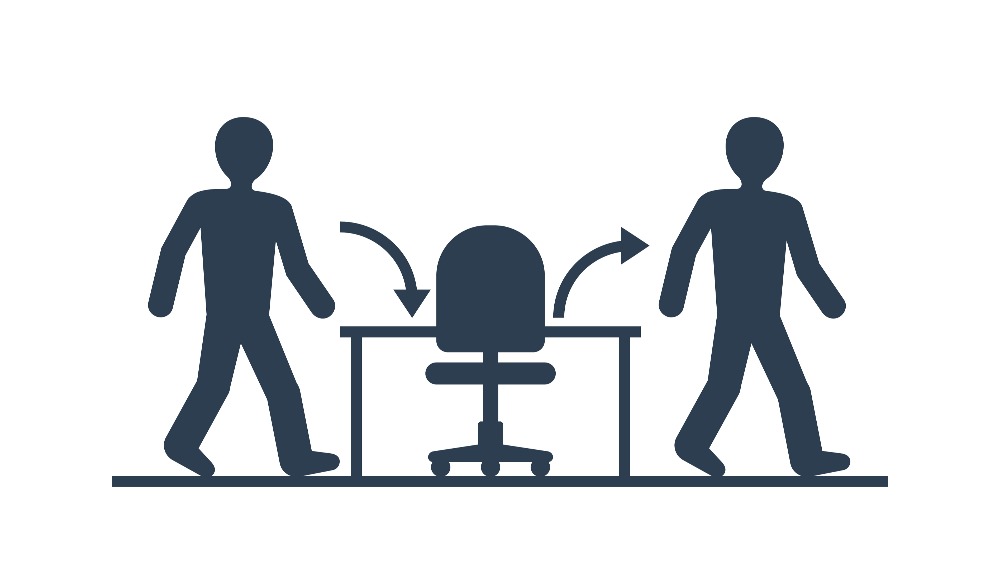Employee attrition: What is it and how can I improve it?

The pandemic marked the onset of an unprecedented churn in the global labour market, the so-called ‘Great Resignation’. Indeed, since April 2021, McKinsey reports that more than 19 million US workers have quit their jobs and 53% of employers said that they are experiencing greater voluntary turnover than they had in previous years. Though reasons for employee departures are diverse and often personal, The Pew Research Center found that low pay, lack of opportunities for advancement and feeling disrespected at work were amongst the top drivers for departing employees. It appears employers are not always doing enough to keep their employees happy. As the war for talent ensues, employees need to address employee attrition holistically and systemically, not just defaulting for a quick, surface-level fix. More often than not, employee attrition is about employee experience – something which is directly in the employer’s control.
This article walks you through employee attrition and how you can reduce departures from your organisation by investing in employee experience.
What is employee attrition?
Employee attrition refers to the departure of employees from your organization for any reason (both voluntary and involuntary), including, but not limited to, resignation, termination, death or retirement. Employee attrition is not necessarily a negative metric. All organisations experience attrition to some extent. Attrition that is not related to how employees feel about their job are usually out of the employer’s control. This type of attrition can include employees leaving the workforce altogether, changing industries, or moving away. However, if you are seeing significant voluntary or demographic-specific attrition, this may indicate an internal issue that should be addressed.
Types of employee attrition
Employee attrition can be broadly categorised into four key types:
Voluntary attrition
This is when an employee leaves voluntarily. This type of attrition is closely linked to employee experience.
Involuntary attrition
As the name suggests, this type of attrition is involuntary. For example, if the employer terminates an employee or dissolves their position within an organisation, this would constitute involuntary attrition.
Internal attrition
Internal attrition is where an employee doesn’t actually leave the organisation completely, but moves internally to another section of the business.
Demographic-specific attrition
If a specific demographic of your workforce leaves, this is what is known as ‘demographic-specific attrition’.
How to calculate employee attrition rate
Calculating your organisation’s employee attrition rate is straightforward. Here is a basic employee attrition rate formula that you can use:
number of employees that have left in a set period (for example, one year)/ average number of employees = employee attrition rate
- First, you need to calculate your average number of employees. You can do this by adding your beginning of year headcount to the end-of-year headcount and diving this by two.
- Secondly, total up the number of employees that have left over the course of the year.
- Factor these numbers into the formula above, and you’ll have your organisation’s employee attrition rate.
Remember not to consider this number in isolation. You need to contextualise it within the size and nature of your specific business. Equally, even if you seem to have a fairly low attrition rate, check to see whether any specific sections of your organisation are witnessing more departures than others.
The difference between employee turnover, attrition and churn

Employee churn, attrition and churn are all terms that refer to employees leaving your company. However, their exact definition is tricky to define exactly. They are often used interchangeably, but depending on the organisations, you’ll also find different interpretations. Unfortunately, a quick Google search is likely to result in a number of conflicting definitions.
Regardless of which definition you opt for, it’s always important to focus on the reason why the employee is leaving, ensuring to differentiate between voluntary and involuntary attrition. The reason this is so important is that this tells you which departures are within your control and which are not (more on this later).
Though you will encounter instances where the term is used differently, employee attrition is typically used to refer to employees that leave for involuntary reasons. This is important to note because it means that employee attrition rate is most probably not a negative reflection of your business. It also means that often employee attrition is not within your direct control.
Employee turnover, by contrast, often refers to voluntary departures. If you are experiencing significant turnover, it’s important to take the time to understand the exact reasons employees are defecting. You should then take the necessary measures to address evident pain points, since losing high-talent employees is very costly to your business.
Given the often personal nature of employee attrition, it’s also important to remember that the reason why somebody chooses to leave is often not clear cut between voluntary and involuntary. There may be borderline cases that blur the lines or are a combination of the two.
It’s also up to you to define certain types of departures. For example, if you have chosen not to offer a hybrid work policy and employees leave as a result, you need to decide whether or not to define this as voluntary or involuntary. As the world of work changes, employees’ expectations do too. As an employer, it’s up to you to adapt (or not).
Reasons for employee attrition
As we’ve seen, employee attrition can be voluntary or involuntary. Within this, there are a number of reasons such as:
Voluntary attrition
Voluntary attrition is where an employee chooses to leave because of changes in their personal circumstances or because of a negative employee experience. Changes in personal circumstances include:
- Planned retirement
- Career change
- Moving away
- Starting a family
Examples of negative employee experiences include:
- Negative work environment or employee experience
- Lack of alignment with the workplace
- Perceived absence of professional growth opportunities
- Lack of motivation
Involuntary attrition
Involuntary attrition is not a reflection of your employees’ experience with your organisation. This also means you can’t do much to prevent this kind of attrition. Examples include:
- Position is dissolved by employer
- Layoffs
How to reduce employee attrition
The Work Institute categorises reasons for employee departures into two types: preventable and less preventable. It also found that 63.3% of departures in 2021 were for more preventable reasons such as management, total rewards, career issues and aspects of the job itself. Some types of employee attrition don’t need to be addressed. For example, retirement or planned layoffs are natural elements of an organisation’s lifecycle, and fall under the Work Institute’s less preventable category. However, if you’re seeing substantial departures due to negative employee experience, this is something that you should seek to remedy. To reduce rates of involuntary employee attrition, here’s what you can do:
Invest in employee experience & development
Investing in your employees present and future is key to building a people-centric organisation that clearly values its workforce and maximises its potential. Employee experience is nuanced and multi-faceted, and for obvious reasons, is a rather personal metric.
That being said, ensuring that your employees feel valued and empowered is a big step towards maintaining their satisfaction at work. For most employees nowadays, their job is about much more than a transactional and impersonal pay slip – workers are seeking a ‘renewed and revised sense of purpose…they want to feel valued by their organisations and managers.’ This is increasingly important given that 54% of employees surveyed by Mckinsey cited not feeling valued by their organisation as a reason for leaving. In this context, improving the employee experience is key for your overall organisational health.
Improve your workplace culture
Establishing and continuing to cultivate a positive workplace culture is absolutely vital for reducing employee churn and maximising retention. It’s important not to overlook the demographic-specific importance of a strong workplace culture. According to Mckinsey, employees who classify themselves as non-white or multiracial are more likely to leave because they don’t feel a sense of belonging at their organisation. This is why identifying and committing to key core values as a business, and making sure these are abided by throughout your organisation is so important. Technology can help you boost a sense of belonging at your company.
Platform such as SquadPal, whose Communities feature helps employees find others with similar identities or interests to them, and take part in challenges, competitions, and games within those communities.
Employers should also consider the importance of physiological safety in their workplace culture is this too is crucial for improving employee attrition
Assess your compensation packages
Salary and compensation are inherently linked to employee satisfaction. You should regularly reassess your compensation and benefits packages, to make sure they align with employee expectations. You should also be doing your research to ensure your total compensation package overall is attractive compared to your competitors. Additionally, equality of pay within your organisation is critical for employee retention. You should, as far as possible, maintain transparency around compensation and ensure thorough salary parity throughout your organisation.
Strengthen your hiring processes
Your hiring practices may be directly impacting your rate of employee attrition. In fact, according to Harvard Business Review, 80% of employee churn can be attributed to bad hiring decisions. If you don’t have robust processes in place that ensure potential hires are the right fit for your organisation, you may be creating an environment of chronic incompatibility. If a worker fundamentally isn’t the right fit for your business, you’re likely to see far bigger rates of departure.
Ask for feedback
When it comes to improving your workplace and organisation, your biggest and richest resource is your employees themselves. Ask for regular feedback and proactively act on your findings. Demonstrating a commitment to constant improvement and valuing their opinions is a great step forward. Additionally, when you do have departures, ask the leaving employee to fill out an exit survey. This will help you to better understand why people are choosing to leave.
Invest in technology
Technology is a key element of employee experience and should not be overlooked. Though it’s most definitely worth addressing intangible concepts such as company culture, technology and automation are concrete steps that you can take to actively improve your employees’ experience. This process is what is known as ‘enablement’. Enablement is the process of providing a particular type of equipment or technology, or the necessary type of system or device to use it. In a business context, this relates to rolling out key technologies that facilitate and enhance the employee experience. Over half of employers surveyed by the Wall Street Journal said that outdated and inadequate technology directly impacted their ability to retain workers. That’s why rolling out a unified technology solution like Zelt that doesn’t simply answer your technological needs, but plays an active role in improving the employee experience should be an integral part of your employee retention strategy.
Zelt is unique in that it is a unified workspace platform that brings HR, admin, payroll and app and device management together. Using this type of software helps you to increase transparency within your organisation, encourage open lines of communication, and crucially, improve your employees’ experience.
FAQs about Employee Attrition
Are employee turnover and attrition the same?
Employee turnover and attrition are similar but not synonymous. As we saw earlier, turnover is a short-term metric that looks at employees that leave and are then replaced. Meanwhile, attrition typically looks at departures that are not immediately replaced.
What is an example of attrition?
An example of employee attrition could be a worker retiring or being terminated.
How does employee attrition affect a business?
Certain aspects of employee attrition are normal parts of an organisation’s employee lifecycle. However, if your business is suffering a particularly high rate of attrition this could result in the unexpected shrinkage of your workforce. This can be damaging to your business in more ways than one, impacting the scalability and productivity of your organisation, as well as impacting the motivation of your remaining workers.
How can my organisation overcome employee attrition?
Certain types of employee attrition are unavoidable. However, employers can work to holistically improve employee experience and invest in their employee retention strategy in order to reduce the rate of employee attrition.
Does employee attrition include termination?
Yes, one type of employee attrition is termination. Termination falls under the ‘involuntary attrition’ category. Use this redundancy pay calculator to find out if you have to pay Statutory Reduncacy Pay.


